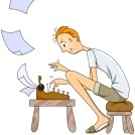
Rndballref
20 Years Experience
Chicago, IL
Male, 60
For twenty years I officiated high school, AAU and park district basketball games, retiring recently. For a few officiating is the focus of their occupation, while for most working as an umpire or basketball referee is an avocation. I started ref'ing to earn beer money during college, but it became a great way to stay connected to the best sports game in the universe. As a spinoff, I wrote a sports-thriller novel loosely based on my referee experiences titled, Advantage Disadvantage
Sounds like a bad call. The center for Team A does not establish team possession by tipping the ball, but by knocking the ball out Team B gets the ball. Because neither team had possession and B got the first ball the arrow is set for Team A's possession on the next one.
yes.
I can honestly say I have never noticed that.
Out of bounds calls should not be missed because in a 3 man crew, every line has an official with primary responsibility. If this really is a trend it is not good.
Dry Cleaner
 Why do dry cleaners have autographed pictures on their walls?
Why do dry cleaners have autographed pictures on their walls?
"The Onion" Contributors
 What's your favorite Onion headline of all time?
What's your favorite Onion headline of all time?
Wills and Estates Lawyer
 Can I leave everything to my pets?
Can I leave everything to my pets?
In theory, swatting a defender's arms is a violation. If a defender has the right to a space, swatting his arms is a foul. But if the defender is handchecking (or forearm checking) an experienced ref would either call a foul on the defender, or not call anything. Instead he could warn both players to keep their arms off each other. Unfortunately, often the offensive player gets caught swatting because the ref missed the initial armcheck.
If the player had two hands on the ball and pushed it to the ground it is double dribble. If the play had one hand on top of the ball and pushed it to the ground it would be a dribble. If he then picked the ball up, he could not dribble again.
The ball is still inbounds, unless the player who is out of bounds touches the ball. So, in your question, assuming the out of bounds player is not touching the ball ... PLAY ON!
-OR-
 Login with Facebook
Login with Facebook (max 20 characters - letters, numbers, and underscores only. Note that your username is private, and you have the option to choose an alias when asking questions or hosting a Q&A.)
(A valid e-mail address is required. Your e-mail will not be shared with anyone.)
(min 5 characters)
By checking this box, you acknowledge that you have read and agree to Jobstr.com’s Terms and Privacy Policy.
-OR-
 Register with Facebook
Register with Facebook(Don't worry: you'll be able to choose an alias when asking questions or hosting a Q&A.)